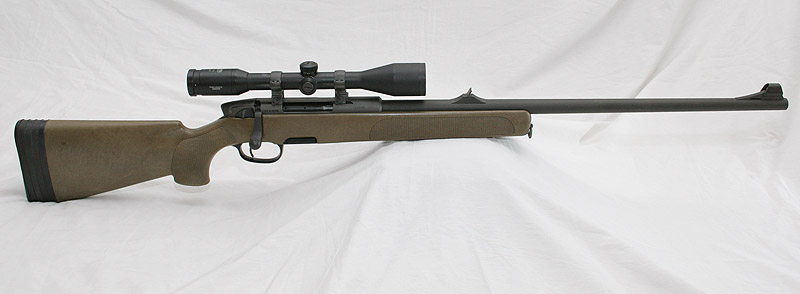
.243 Winchester
|
Back in the mid 1960's when sniping once again came to the forefront of military leaders, the Austrian Army decided it needed to prepare their own snipers and properly equip them. The search for a proper weapon system was begun at that time and in 1969, Austrian based Steyr began building the new rifle which was paired with a Kahles ZF69 fixed 6x scope, Kahles also being an Austrian based company. The SSG-69, as it was designated, became the standard sniper rifle of the Austrian armed forces. The SSG-69 was also available on the civilian market where it is also commonly known as the PI (Roman numeral one) and it quickly became known as a very accurate rifle, even winning several prominent international competitions. Later a second version, the PII, was developed that included a heavier barrel without any iron sites and it was tailored toward the law enforcement community. A short version, known as the PIV, was also created and was designed for urban style operations and was setup to accept a suppressor. Here at Sniper Central we have shot several SSG-69's over the years and had always been impressed with the performance Steyr gets out of their rifles, but we had never ran one through a full series of tests or conducted a full write-up. One of the things we like to do is introduce readers to some of these less common sniper rifles that have played an integral part in sniper rifle development over the years and then see just what type of capability these rifles had in their day as well as compare them to today's breed of sniper rifles. The SSG-69 series of rifles is still in production from Steyr, but the design is over 40 years old and really nothing much has changed over those years. So we thought we would pick one up and give it the full evaluation to see just what it could do. Since we tend to prefer function over beauty, we elected to pick up the original PI version since it was what the Austrians came up with as their desired combat sniper rifle in 1969. Now it was time to see what this old classic could do compared with today's rifles. 
One of the first things someone notices about the PI is that it looks somewhat like a sporter rifle, especially when there is no optics
mounted. This is somewhat reaffirmed when you pick up the rifle, as it is quite light when compared to the modern custom built sniper rifles
available today. The empty weight of the rifle, without optics, is only 8.8 lbs which is very similar to many modern hunting rifles on the market. The
auxiliary iron sights also give the impression that this is more of a hunting rifle than a tactical sniper rifle. Though the colors of the rifle are certainly
very business-like with the synthetic stock being green and all the metal parts are finished in a matte black color that offers no reflection.
The stock itself is made of fiberglass type of material and if one recalls, back in 1969 this was very much a revolutionary thing. All sniper rifles at the time were still using wood stocks, and this included the recently adopted M40 being used by the USMC, the US Army M21, German SP66, and all the others. While this may not have been the first ever use of a synthetic material for a rifle stock, the fact that Steyr was using them as standard on the SSG-69 was certainly pioneering. The stock does feel somewhat like a generic piece of hard plastic, similar to a M16A1 buttstock, and the molded fiberglass itself is smooth and slippery, especially when combined with sweat and other things such as face paint, and getting a solid cheek weld in all conditions can be tough. The buttstock is hollow which helps with keeping the weight down, and the shape of the stock is not bad. The stock may not have a modern vertical pistol grip with palm swell, but it does sweep down to a vertical position and there are serrations on the grip area to help with getting a firm grip. These same serrations are found on the forearm area as well. The forearm area also has a flat underside that is 2" wide at the magazine and tapers down to 1.5" wide at the front. This flat area provides a good solid platform when shooting from sandbags or other rests. There is also a standard accessory rail on the bottom of the forearm to allow mounting sling studs and bipods. The stock also has an integrated sling attachment point on the left hand side of the buttstock and when combined with the front sling attachment that is at the very front of the forearm and swivels, it allows the rifle to lay flat on its side against the operators back when it is slung. When the rifle must be slung, either when utilizing a different weapon or needing both hands free for such things as climbing and/or repelling, this is a preferred way of slinging the rifle. The buttstock also has a spacer system that allows for adjusting the length of pull by adding or removing spacers. 
The Steyr SSG action is fairly long and thick and this was done to strengthen and stiffen the action to help improved accuracy. The forward
part of the action is longer than most others as the barrel is seated much deeper into the action than a typical modern bolt action rifle. This
also was done to help strengthen the barrel to action mounting and to increase the stiffness of the entire barreled action as a whole. The barrels
are not threaded into the receiver but rather the receiver is heated and then cooled around the extra long barrel tenon. This also means the
barrels can typically only be replaced
by the factory. The top
of the action has milled groves in it to accommodate Steyr scope mounting rings. Back in 1969 there was no standardized Picatinny rail as there
is today and there is no means of mounting any sort of rail as the action is not drilled and tapped.
The SSG action is a closed top design with a decently sized ejection port. The closed top does add additional stiffness to the action, though it can limit accessibility to the interior of the action if that is ever needed. If it is not obvious yet, Steyr pulled out all the tricks known at that particular time to stiffen and strengthen the barreled action in an effort to improve accuracy and durability of the rifle. There is a safety on the right hand side of the action toward the rear. It is a fairly large thumb switch that has two positions. Forward is fire and then pull it to the rear using the thumb and the rifle is on safe. When the safety is activated the bolt is locked and the trigger mechanism is deactivated. With the detachable box magazine, it is easy and safe to unload the rifle with the bolt locked in this manner. 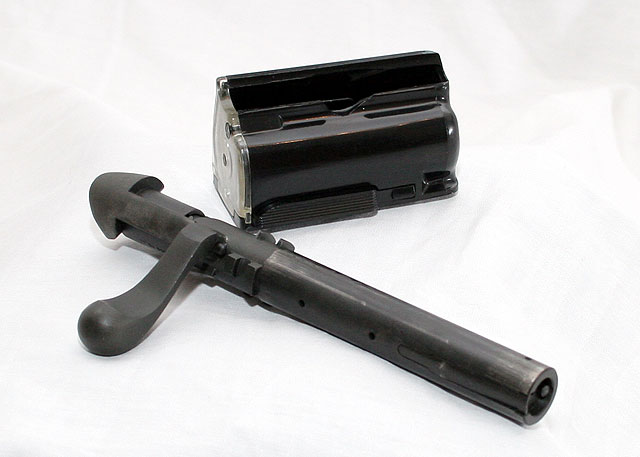
The SSG bolt is a fairly unique design, certainly different than the standard American made rifles such as Remington 700s, Savage 10s and 12s,
Winchester 70s and others. The bolt has six lugs at the rear of the bolt instead of the standard two at the front. This arrangement allows for a
short bolt throw, in the neighborhood of 60 degrees, which does allow for quick cycling of the action without fear of interference with the scope.
The bolt handle itself is somewhat short and has what some would call a "butter knife handle". While it is not a large bolt knob design like what is
popular today, the shape is contoured to fit the natural grip of the hand and works well with and without gloves on. The bolt also has a little
protrusion that extends from the rear of the bolt shroud providing a visual cue that the rifle is cocked and ready to fire. The extractor is a nice
M-16 style extractor that provides positive clamping power onto the case of the cartridge. The operation of the bolt is smooth and short and works
well for a combat sniper rifle.
The trigger guard is made of a hard plastic and the opening is oversized to allow the use of a gloved trigger finger with no problem. The hard plastic raises a concern of durability but it feels strong and there have been minimal reports of durability issues with the rifle as a whole. The large trigger guard is also able to accommodate a double set trigger which is optional, if not more common, on these rifles. The double set triggers are typically only suitable for accurate range work as the second trigger is extremely light for competition shooting. For tactical duty the single two-stage trigger is preferred and is what is present on this test rifle. The trigger shoe is ribbed to help with trigger feel and the trigger itself has a nice light first stage. The amount of takeup of the first stage is fairly short, under a quarter of an inch, and the second stage is heavier and brakes very clean at 4 lbs with minimal over travel. This is a bit heavier trigger pull than a typical precision rifle today, but the SSG was designed as a combat rifle and as such, it makes a good fit, especially with the nice clean trigger break. 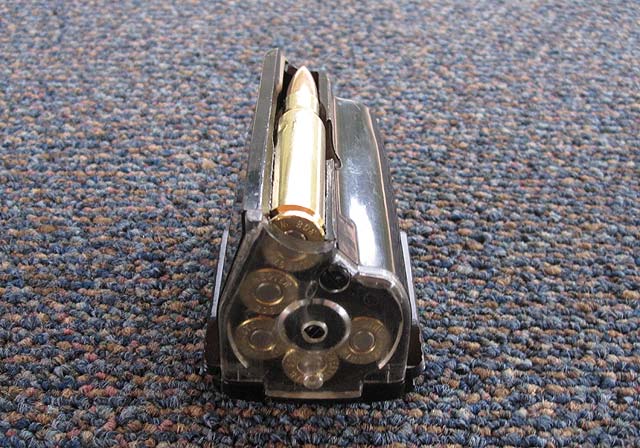
In front of the trigger guard is the flush fitting detachable box magazine. The magazine itself is unique by today's standards as it is not a single
or double stack magazine but rather a rotary magazine. As the rounds are loaded into the magazine they feed in a rotary fashion. The standard flush
fitting magazine holds five rounds and the rear wall of the magazine is made of a clear plastic that allows for easy identification of how many rounds
are loaded. The magazine is releases by squeezing the two magazine release buttons on either side of the magazine. This is the same way that the standard
Remington 700 DBM works, though the Steyr implementation operates better than the Remington. The magazines snap in with a good positive click and with
minimal effort. When inserting a magazine, it is easy to find the mag well and perform rapid magazine changes. For a while Steyr also made a ten round
magazine that protruded down below the rifle but these are very hard to come by and in high demand which drives the prices up.
As was mentioned earlier, the barrel on the Steyr SSG threads very deeply into the forward action for added strength and stiffness. The barrel itself is a lighter weight barrel than the typical sniper rifle today. The contour is what would be considered a medium to heavy weight sporter contour, with the barrel being just a bit heavier and thicker than a normal sporting rifle today. The diameter of the barrel at the muzzle is .715" (18.2 mm). The barrel is cold hammer forged and has a measure rate of twist of 1:12". The outside perimeter of the barrel is finished in a spiral pattern that adds a high quality finished look to the barrel and the crown is recessed as well to protect it during operations. The barrel is listed at 25.6" in length, but that is measured from the start of the barrel inside of the receiver, so the length of the barrel from the front of the receiver to the muzzle is only 23.4". On the SSG69 PI there is a set of open sights that work well as backup auxiliary sights for those times when Murphy's laws of combat come into play and your primary scope goes belly up. 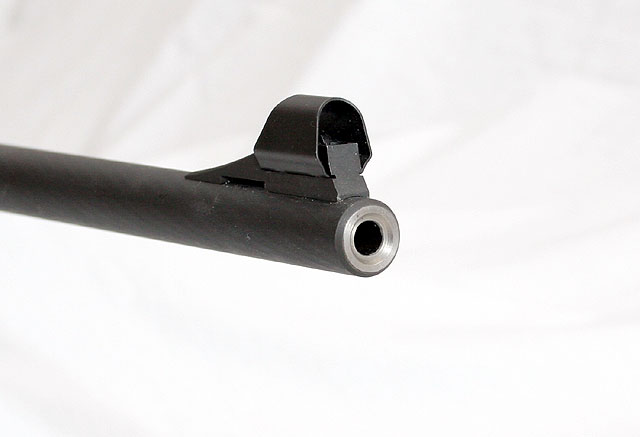
Overall the rifle is a compact and lighter weight rifle than what is typically considered for sniper use today. All of the correct parts are there in
terms of a synthetic stock, durable and matte color metal finish, detachable magazine, solid action, short bolt throw, two stage trigger, larger trigger
guard, bolt handle designed for gloved hands, but yet the rifle is still light weight and fairly compact. The real question now stood as to whether the
rifle can perform to modern standards for combat sniper rifles.
One down side to the rifle being designed in the 1960's was the concept of a picatinny rail was not the standard and there was no standardized way to mount a scope. The Steyr in this case utilized notched grooves in the top of the receiver and some specially designed rings to be used with a scope. These Steyr designed rings are a quick release style that incorporates features that keep things tightly in place during recoil. Typically we are not a fan of quick release style rings and we would even caution away from using them if you have a choice but in this case, the receiver is not drilled and tapped for any type of scope mounts, so the Steyr QR rings were the only option. In fairness, it should be mentioned that we did not run into any problems at all during the entire review process. The rings held tight and the rifle stayed zeroed. It also needs to be pointed out that the rings are specifically setup to go on one way and one way only. There is a forward and a rear ring and if they are flip-flopped the scope has a severe downward cant, upwards of 60 MOA. Also, the quick release lever must be on the right hand side of the action, else there is a severe right cant. Do not ask us how we know... Sniper Central acquired this rifle with the intention of using it for many different write-ups and evaluations, so we wanted a scope that would match the rifle and we could leave mounted. What better scope fits that bill than one that was intended for use on the SSG69 PI? Originally the mated scope was a Kahles ZF69, which is a fixed 6x40mm scope with Bullet Drop Compensator (BDC) calibrated for the 7.62x51mm 168gr ammo. This scope and rifle combination made for an effective sniper weapon system out to 600 meters and perhaps a bit beyond. As time progressed, it was determined a more powerful scope would be beneficial so the Kahles ZF84 was adopted. The ZF84 is a fixed 10x40mm with the same BDC as the ZF69 and this combination extended the range of the rifle to 800+ meters. This was the scope that we chose for the Sniper Central SSG69 PI. A nice sample had to be found on the used market as these scopes do not appear to be available any longer. With the scope selected and purchased, it was mounted using the Steyr rings and the shooting portion of the evaluation begun. 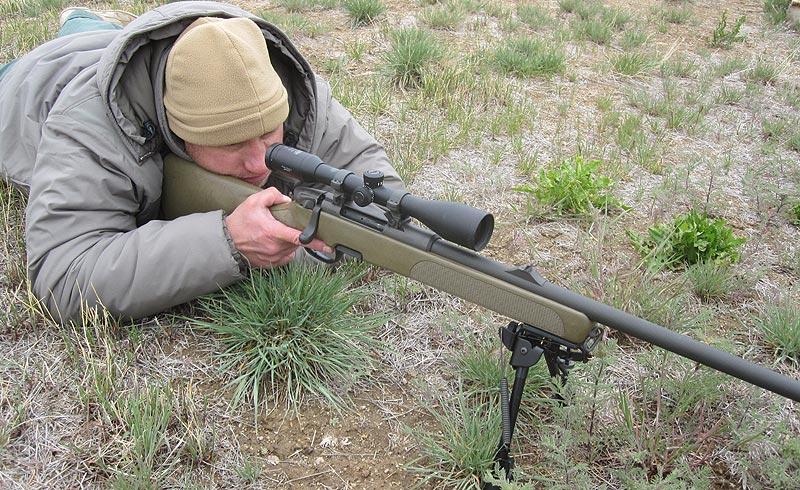
We did not known which ammo would perform best in the SSG so for our 100 yard accuracy tests we decided to try several different loads and bullets to see
if there was one the rifle preferred over the others. The summary of the results can be seen in the table below.
As you can see the rifle performed well, and the HSM 168gr AMAX did exceptionally well. The shooting was conducted over several different shooting sessions which ranged from 40 degrees in temperature up to 75. The four pound trigger does make it more difficult to get the most out of the rifle so focusing on a good consistent trigger squeeze is critical for getting the best performance. Because the barrel is a thinner profile, it does heat up quicker but no change in performance or shift of impact was noticed. It is obvious when operating the rifle that the action was designed to feed from a magazine since it was very smooth with no feeding problems experienced at all. Though it is not possible to just drop a single round in the action and easily chamber it, like one can do with a Remington. It was also noticed that occasionally during bolt manipulation; the extracted shell would flip out but bounce back into the chamber during extraction. This was odd and it happened several times. Obviously this would cause a problem during combat operations and some adjusting may be needed to the bolt or extractor. The accessory rail on the forearm came in handy to mount a Harris bipod to and the stock itself was comfortable to use, though the material is a smooth and can be a bit slippery. A strap-on cheek pad would probably be desirable to help with the cheek weld. Because of the short bolt through, rapid follow-up shots are fairly easy. 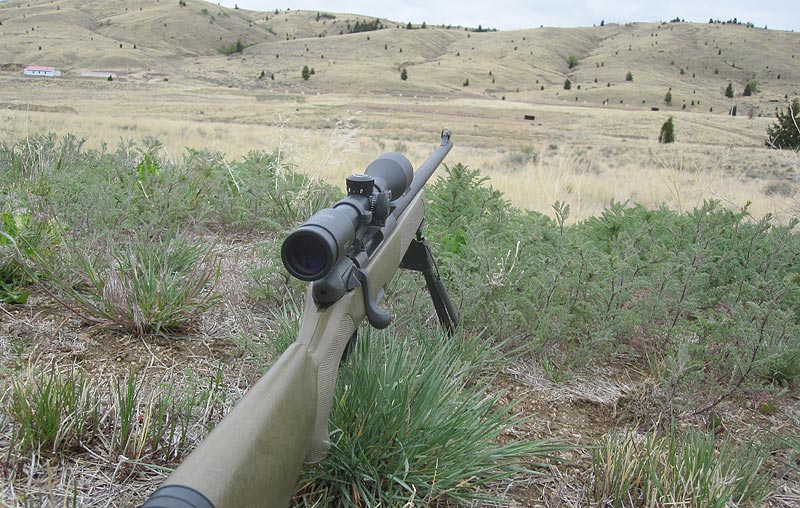
For our long range evaluations we initially started off with the HSM 168gr AMAX load because it performed so well at 100 yards. We shot the rifle
on one of our Unknown distance courses for one of our classes and we engaged targets out to 750 yards (686 meters) with very good success, but
only after we got the scope dialed in correctly. The problem was that the BDC dial on the scope was indicating 550 yards in order to hit the 750
yard target, which obviously was way off. The rifle performed very well, but we were wanting to get a deadly sniper weapon system combination
from this package so the next time out we took the Steyr to the known distance range and decided to see what was going on from 100-800 yards, and
this time around we used decided to use the HSM 168gr HPBT ammo which uses the Sierra Match King at an even 2600 fps, exactly the load the BDC was
designed for, and we also determined that the BDC marks were probably calibrated in meters, not yards. The 168gr AMAX bullet has a BDC of .475 vs.
.447 for the 168gr Sierra Match King, which would also explain why the BDC was so far off. So with the Steyr rezeroed with the new ammo we started
logging the data at each 100 yard increment. Lo and behold, the BDC was dead on through 400 yards (366 meters) and then started to be slightly off
from 500 yards (458 meters) thorugh 800 yards (732 meters). The data was just slightly off, again the bullet striking higher than the BDC marks which
we attributed to the higher elevation (5000+ feet above sea level) and warmer temps than standard atmospheric conditions.
With everything figured out and dialed in on the scope, the rifle performs very well with it holding sub MOA through 800 yards. Even after running a good number of rounds through the rifle in a single session, it continued to perform well and to hold its accuracy. We did not try the auxiliary sights this time around, but perhaps we will another time, though we have no reason to believe they would not work as designed. So where does that leave this 'classic' sniper rifle in the grand scheme of things? In our eyes, it stacks up well, especially for its intended purpose as a combat style sniper rifle capable of effective 100-800 meter engagements. The light weight is surprising when compared to modern sniper rifles and it is quite handy to use in the field. In the hands of the right team with utilizing good fieldcraft, it would be extremely effective. If we look at the requirements for our DM/S project rifle we see the following:
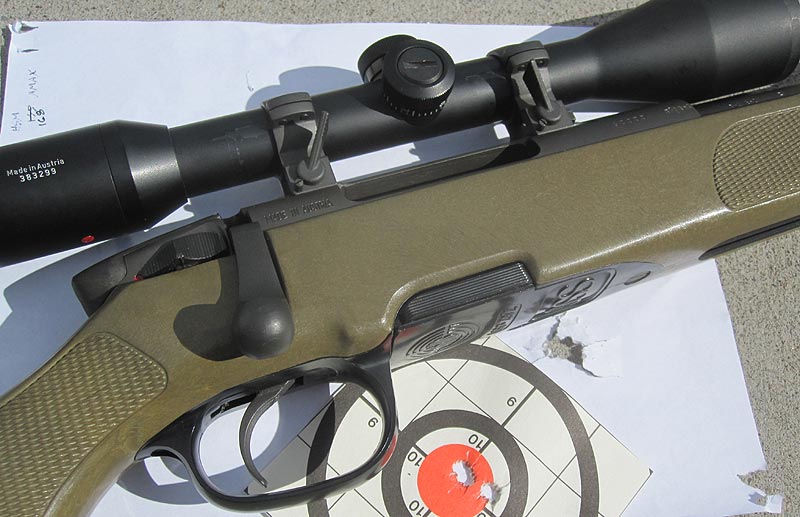
Additional Images SSG69 PII SSG69 PIV SSG69 in use by Saudi Armed Forces (thanks Lt. Col W.) SSG69 in use by Saudi Armed Forces (thanks Lt. Col W.) SSG69 in use by Saudi Armed Forces (thanks Lt. Col W.) Sniper Central, June 2012 |